| Picture |
Information |
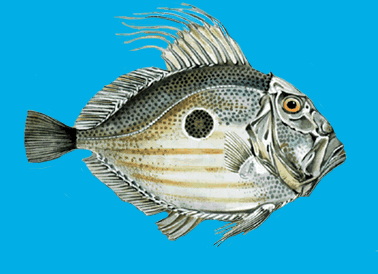
|
John Dory(Zeus faber) -
Recognised by the distinctive black spot in the middle of the fish and the large,bony head.
Habitat -
Found in areas close to the sea bed.
Diet -
Feeds mainly on schooling bony fish, occasionally on cephalopods and crustaceans.
|
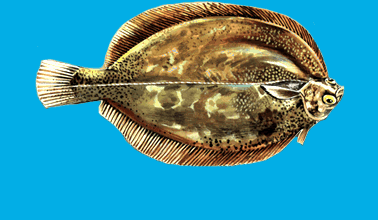
|
Lemon Sole (Microstomus kitt) -
It has a smooth skin,light brown in appearance.
Habitat -
Found on hard or gravel bottoms, at 20m - 150m.
Diet -
It feeds on small invertebrates, such as worms, sandhoppers and barnacles.
|
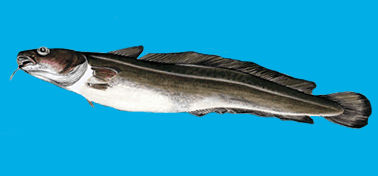
|
Ling (Molva molva) -
Upper jaw projecting beyond lower one. Color is reddish brown dorsally, grading to white ventrally. The posterior areas of the vertical fins dark with pale margins. The sides distinctly marbled.
Habitat -
Adult ling live mainly in water up to 400m. It prefers the cover of seaweed, heavy rock or big wrecks. Younger fish will usually be found in shallow water under the protection of rocky ground.
Diet -
It will feed on all kinds of fish including flatfish, octopus, crustaceans and starfish.
|
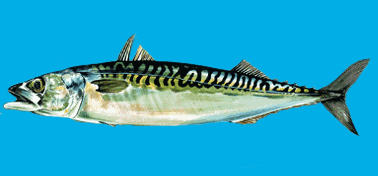
|
Atlantic Mackerel (Scomber scombrus) -
Markings on the back oblique to near vertical, with relatively little undulating; The belly is unmarked.
Habitat -
The Mackerel, can be caught during the summer months shoaling along the UK coasts in large numbers.
Tactics:
Float, spinners, but mainly Feathers are used fishing up to 6 feathers at a time.
|
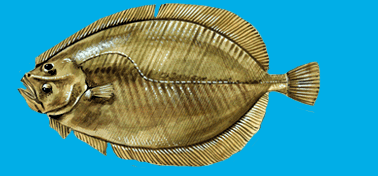
|
Megrim (Lepidorhombus whiffiagonis) -
Oval shaped fish with a rough dark brown lightly spotted skin.
Habitat -
It lives on muddy and mixed ground at 100-400 m, and also free swimming.
Diet -
It generally feeds on crustaceans and small bottom dwelling fish.
|
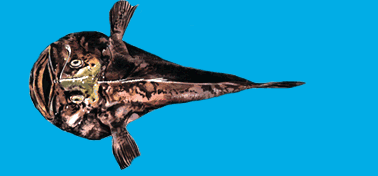
|
Monkfish (Squatina squatina) -
Recognised by the large,broad head and can grow up to 2 metres overall.
Habitat -
Shallow water dwelling shark and close inshore although found to depths of 150m. Prefers mud and sandy bottoms where the shark can bury itself to ambush prey.
Diet -
Mostly flatfish, crustaceans and molluscs.
|
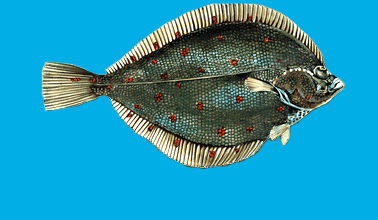
|
Plaice (Pleuronectes platessa) -
Upper side brown or greenish brown with irregularly distributed bright red or orange spots. The underside is white.
Habitat -
Widspread, Found inshore all around Britain, likes to be around sandy / shell/grit bottoms, also can be found close to mussel beds.
Diet -
Lugworm, Ragworm, also Peeler crab in spring.
|
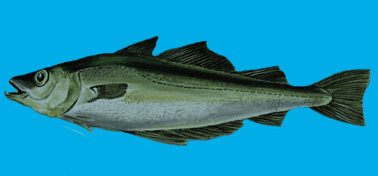
|
Pollack (Pollachius pollachius) -
Body color is variable; dark dorsally, sharply distinguished from silver-gray sides and belly; the upper part of the body with yellow to orange streaks or blotches; the lateral line greenish. The fins uniformly dark except for the pelvic fins which are yellowish.
Habitat -
Bigger fish are found out at sea, around wrecks and reefs etc. Smaller fish can be caught from pier walls and rocky marks.
Diet -
fish, Ragworm, Peeler crabs. Methods - Spinners / Lures often work very well.
|
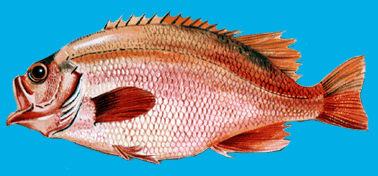
|
Redfish (Sebastes fasciatus) -
These fish grow upto 30cm in length.
Habitat -
Found on rocky reefs and muddy substrates of the continental shelf and upper slope, forming dense schools close to the bottom at dawn and dusk and dispersing throughout the water column at night to feed. Juveniles also aggregate in schools and are found in estuaries and shallow costal waters, rocky or clay silt bottom.
Diet -
Feeds on euphausiids, decapods, mysids, small mollusks and fish.
|
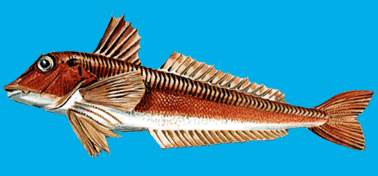
|
Red Gurnard (Aspitrigla cuculus) -
Brightly coloured fish bottom feeding fish with sharp spines and a comparatively large head and thick skin.
Habitat -
Occasionally forms schools. Found over sand and gravel, crag, and rocks in the continental shelf.
Diet -
Feeds on benthic crustaceans, and other invertebrates and bottom dwelling fish.
|

|
Red Mullet (Mullus barbatus barbatus) -
A small red fish with large scales.
Habitat -
This bottom dwelling fish is to be found over sands and muds in small shoals, and favours inshore waters during the summer months, although it is not uncommon in rocky areas.
Diet -
It uses it's barbels to search and locate invertebrates such as crustaceans, worms, and molluscs, along with the occasional small fish.
|
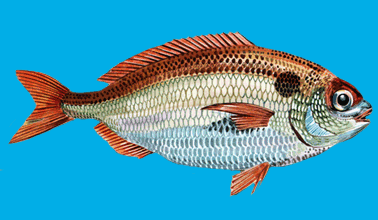
|
Red Sea Bream (Pagrus major) -
Body with many bluish dots when fresh.
Habitat -
Rocks and seaweed of shallow waters, down to depths of 250 m or more. This tends to be a shoal fish, although the size of the shoals decrease with age of the fish. Red Bream have a summer inshore migration, and is the most common of the sea bream in the UK.
Diet -
Small fish, crustaceans and the occasional squid.
|
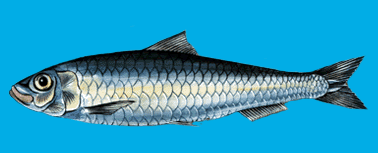
|
Sardine (Sardina pilchardus) -
Silver in colour with a blue back.
Habitat -
They form schools, usually at depths of 25 to 55 or even 100 m by day, rising to 10 to 35 m at night.
Diet -
Feed mainly on planktonic crustaceans, also on larger organisms.
|
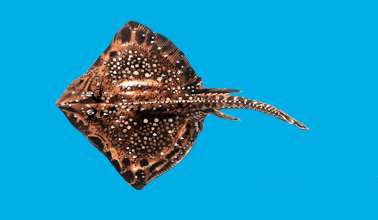
|
Skate (Dipturus batis) -
Skate and Ray has a distinctive diamond-shaped body. The upper surface is olive grey or brown with a variable pattern of light spots, and the underside is ashy grey to blue grey.
Habitat -
Found in coastal waters mainly within the 100m - 200m range.
Diet -
They feed on all kinds of bottom animals, large individuals prefer fish.
|
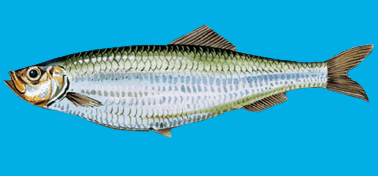
|
European Sprat (Sprattus sprattus) -
Silver in colour with a blue back.
Habitat -
Usually inshore schooling, sometimes entering estuaries (especially the juveniles).Their usual depth range is 10m - 150m.
Diet -
Feeds on planktonic crustaceans.
|
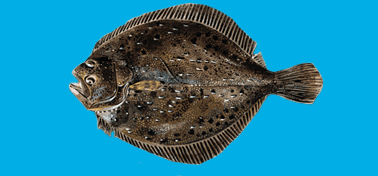
|
Turbot (Psetta maxima) -
Body almost circular with eyes on the side, also without scales but with large bony tubercles.
Habitat -
Turbot generally inhabit waters of 20m - 80m, Adults live on sandy, rocky or mixed bottoms; rather common in brackish waters.
Diet -
Food consists mainly of small fish, such as sandeels, gobies and sprats, but turbot may also take crustaceans and molluscs.
|
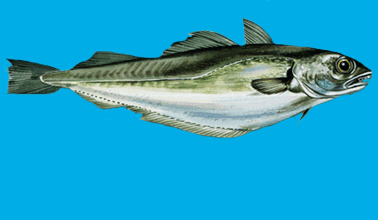
|
Whiting (Merlangius merlangus) -
A member of the Cod Family. Their colour is variable, a yellowish brown, dark blue or green, with yellowish grey sides, and white and silvery on the belly, often with a small dark blotch at the upper base of the pectoral fin.
Habitat -
More commonly found from 30 to 100 m, mainly on mud and gravel bottoms, but also on sand and rock. They migrate to the open sea only after the first year of life.
Favourite Baits -
They feed on Shrimps, Crabs, Mollusks, small Fish, Polychaetes and Cephalopods.
|
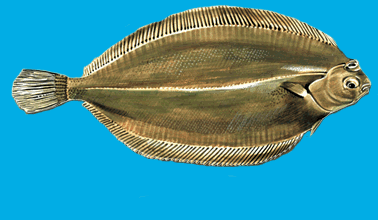
|
Witch - (Glyptocephalus cynoglossus)
A right sided flatfish with a small head and mouth.
Habitat -
Lives on muddy grounds at depths of 100m - 400m.
Diet -
Feeds on worms, crustaceans and molluscs.
|

